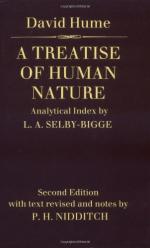We have already seen the influence of the two first qualities of the dye, viz. the causes, and the number and indifference of the sides, and have learned how they give an impulse to the thought, and divide that impulse into as many parts as there are unites in the number of sides. We must now consider the effects of the third particular, viz. the figures inscribed on each side. It is evident that where several sides have the same figure inscribe on them, they must concur in their influence on the mind, and must unite upon one image or idea of a figure all those divided impulses, that were dispersed over the several sides, upon which that figure is inscribed. Were the question only what side will be turned up, these are all perfectly equal, and no one coued ever have any advantage above another. But as the question is concerning the figure, and as the same figure is presented by more than one side: it is evident, that the impulses belonging to all these sides must re-unite in that one figure, and become stronger and more forcible by the union. Four sides are supposed in the present case to have the same figure inscribed on them, and two to have another figure. The impulses of the former are, therefore, superior to those of the latter. But as the events are contrary, and it is impossible both these figures can be turned up; the impulses likewise become contrary, and the inferior destroys the superior, as far as its strength goes. The vivacity of the idea is always proportionable to the degrees of the impulse or tendency to the transition; and belief is the same with the vivacity of the idea, according to the precedent doctrine.
SECT. XII. OF THE PROBABILITY OF CAUSES.
What I have said concerning the probability of chances can serve to no other purpose, than to assist us in explaining the probability of causes; since it is commonly allowed by philosophers, that what the vulgar call chance is nothing but a secret and concealed cause. That species of probability, therefore, is what we must chiefly examine.
The probabilities of causes are of several kinds; but are all derived from the same origin, viz. the association of ideas to A present impression. As the habit, which produces the association, arises from the frequent conjunction of objects, it must arrive at its perfection by degrees, and must acquire new force from each instance, that falls under our observation. The first instance has little or no force: The second makes some addition to it: The third becomes still more sensible; and it is by these slow steps, that our judgment arrives at a full assurance. But before it attains this pitch of perfection, it passes through several inferior degrees, and in all of them is only to be esteemed a presumption or probability. The gradation, therefore, from probabilities to proofs is in many cases insensible; and the difference betwixt these kinds of evidence is more easily perceived in the remote degrees, than in the near and contiguous.




